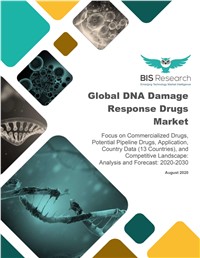Market Report Coverage - DNA Damage Response Drugs
Market Segmentation
- Commercialized Drugs – Lynparza, Talzenna, Zejula, and Rubraca
- Pipeline Analysis (by Mechanism of Action)- PARP Inhibitor, WEE1 Kinase Inhibitor, ATR Kinase Inhibitor, Aurora B Inhibitor, and DNA-PK Inhibitor, and Others
- Application – Ovarian Cancer, Breast Cancer, Pancreatic Cancer, and Prostate Cancer
Regional Segmentation
- North America – U.S., Canada
- Europe – Germany, France, U.K., Italy, Spain, Switzerland, and Rest-of-Europe
- Asia-Pacific – China, Japan, India, Australia, and Rest-of-Asia-Pacific (RoAPAC)
- Latin America – Brazil, and Rest-of-the-Latin America
- Rest-of-the-World
Growth Drivers
- Rising Global Prevalence of Cancer
- Favourable Regulatory Environment
- Increasing Oncology R&D Expenditure
- Increase in Adoption of Precision Medicine in Cancer Treatment
Market Challenges
- High Cost Hindering the Adoption Rate
- Unfavorable Reimbursement Scenario
- Safety Concerns Pertaining to Severe Adverse Effects
Market Opportunities
- Massive Scope in Emerging Regions
Key Companies Profiled
AbbVie Inc., AstraZeneca plc, Bayer AG, BeiGene Ltd., Clovis Oncology, Debiopharm International SA, Eli Lilly & Company, GlaxoSmithKline plc, Merck KGaA, NMS Group S.p.A, Onxeo SA, Pfizer Inc., Repare Therapeutics, Sierra Oncology, Inc., and Zentalis Pharmaceuticals, LLC
Key questions answered in this report:
- What are the major market drivers, challenges, and opportunities in the global DNA damage response drugs market?
- What are the underlying structures resulting in the emerging trends within the global DNA damage response drugs market?
- What are the key development strategies that are being implemented by the major players in order to sustain in the competitive market?
- What are the key regulatory implications in developed and developing regions for the DNA damage response drugs?
- What is the pricing and reimbursement scenario for DNA damage response drugs market?
- What is the implication of the COVID-19 pandemic on the oncology research?
- What are the potential DNA damage response drugs present in the pipeline?
- What is the clinical landscape of DNA damage response drugs market?
- How is each segment of the market expected to grow during the forecast period from 2020 to 2030? What is the anticipated revenue to be generated by each of the segments on the basis of:
- Commercialized Drugs (Lynparza, Talzenna, Zujula, and Rubraca)
- Potential Pipeline Drugs (PARP Inhibitor, WEE1 Kinase Inhibitor, ATR Kinase Inhibitor, Aurora B Inhibitor, DNA-PK Inhibitor, and Others)
- Application (Ovarian Cancer, Breast Cancer, Pancreatic Cancer, and Prostate Cancer)
- Region (North America, Europe, Asia-Pacific, Latin America, and Rest-of-the-World)
- Who are the leading players with significant offerings to the global DNA damage response drugs market? What is the expected market dominance for each of these leading players?
- Which companies are anticipated to be highly disruptive in the future, and why?
- What are the current treatment gaps, and how are DNA damage response drugs anticipated to fill these gaps?
- How does cancer burden impact the development of DNA damage response drugs worldwide?
- What are the unmet needs that are currently being faced?
Market Overview
Our healthcare experts have found DNA damage response drugs industry to be one of the most rapidly evolving markets. The global market for DNA damage response drugs is predicted to grow at a CAGR of 21.33% over the forecast period of 2020-2030. The market is driven by certain factors, which include the rising global prevalence of cancer, favorable reimbursement scenario, increasing oncology R&D expenditure, and an increase in the adoption of precision medicine in cancer treatment.
The market is favored by the developments in the field of oncology research for discovering underlying molecular mechanisms of cancerous cells for the development of novel therapeutics. Moreover, the growing cases of advanced cancer worldwide has significantly escalated the need for developing DNA damage response drugs for solving cancer unmet needs. These drugs have unprecedented potential in terms of offering a selective and efficient tolerated treatment approach for improving cancer survival rates.
Within the research report, the market is segmented on the basis of commercialized drugs, pipeline analysis (by mechanism of action), application, and region. The commercialized drugs segment contains the revenue which is expected to be generated by the successful launch of commercialized drugs that are in Phase III clinical trials and are being evaluated for other cancer indications based on different biomarkers. The pipeline analysis (by mechanism of action) segment covers non-commercialized DNA damage response drugs that are currently in Phase III clinical trials and are being developed as a monotherapy treatment for various cancer indications. Each of these segments covers the snapshot of the market over the projected years, the inclination of the market revenue, underlying patterns, and trends by using analytics on the primary and secondary data obtained.
Competitive Landscape
The exponential rise in the application of precision medicine on the global level has created a buzz among the pharmaceutical companies to invest in the development of small molecule cancer drugs. Due to the diverse product and pipeline portfolio and intense market penetration, AstraZeneca plc has been a pioneer in this field and has been a significant competitor in this market.
Several other companies such as GlaxoSmithKline plc, Pfizer Inc., and Clovis Oncology, have also launched their respective DNA damage response drugs, such as Zejula, Talzenna, and Rubraca, respectively, to compete with Lynparza’s market dominance.
On the basis of region, North America holds the largest share of DNA damage response drugs market due to the availability of capital and cancer research expertise, growing need to develop novel cancer therapeutics, and high adoption of precision medicine, among others. Apart from this, the Asia-Pacific region is anticipated to grow at the fastest CAGR during the forecast period.



